 "QUANTUM SHOT" #627 "QUANTUM SHOT" #627
Link
- article by Simon Rose
We had such a great response to the
first article
about flags here on Dark Roasted Blend, that we thought we’d unearth a few
more examples of fascinating banners from the distant and not so distant
past. Here’s a look at some more flags of forgotten countries.
Epic lands, empires, wars, revolutions - with flags to match them
The flags of Napoleon and his nephew Napoleon III featured in our
first article, but France went though a number of political changes in the nineteenth
century. After Napoleon’s fall, the Bourbon’s returned to the throne,
using this royal coat of arms, with the restoration period under Louis
XVIII and Charles X lasting from 1814 until the monarchy was overthrown by
the July Revolution in 1830.
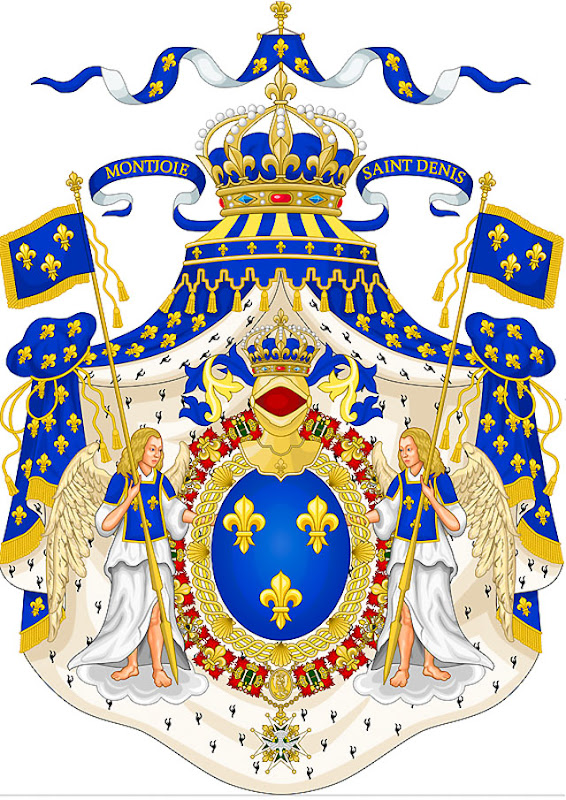 (image
via)
A cadet branch of their own family replaced the Bourbons as rulers of
France. However, their successor, Louis Philippe, was himself overthrown
in the revolution of 1848:
(image
via)
A cadet branch of their own family replaced the Bourbons as rulers of
France. However, their successor, Louis Philippe, was himself overthrown
in the revolution of 1848:
 (images
via)
France of course experienced further upheaval in World War Two, after
defeat to Germany in 1940. This flag was the personal standard of Philippe
Petain, chief of state of Vichy France, which remained unoccupied by the
Germans until November 1942:
(images
via)
France of course experienced further upheaval in World War Two, after
defeat to Germany in 1940. This flag was the personal standard of Philippe
Petain, chief of state of Vichy France, which remained unoccupied by the
Germans until November 1942:
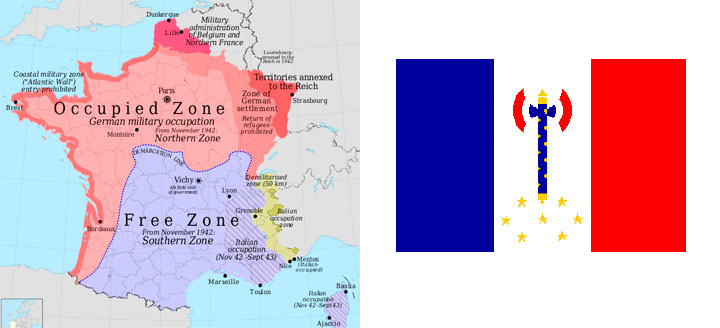 (larger
map
and more info
here)
Also in World War Two, following the fall of Mussolini in 1943 and the
subsequent defection of Italy from the Axis cause, Germany took control of
northern and central Italy. The puppet state established by Mussolini on
Lake Garda, halfway between Milan and Venice, was informally known as
the Salo Republic, which came to an end in April 1945:
(larger
map
and more info
here)
Also in World War Two, following the fall of Mussolini in 1943 and the
subsequent defection of Italy from the Axis cause, Germany took control of
northern and central Italy. The puppet state established by Mussolini on
Lake Garda, halfway between Milan and Venice, was informally known as
the Salo Republic, which came to an end in April 1945:
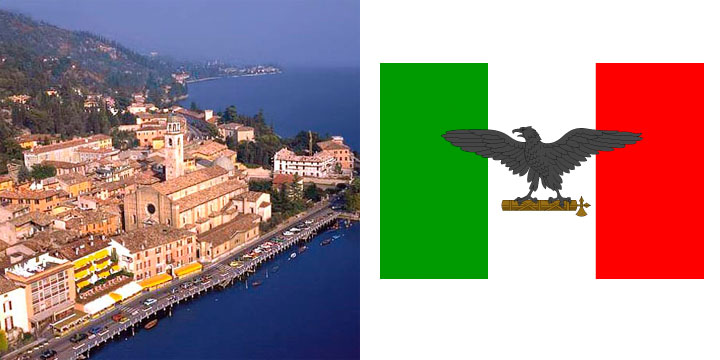 (image
via)
In Asia during the same period, the Japanese puppet state of
Manchukuo was located in Manchuria and parts of Inner Mongolia.
Established in 1932, the government was headed by Puyi, the last emperor
of China, until the end of the Manchukuo state following the defeat of
Japan in 1945:
(image
via)
In Asia during the same period, the Japanese puppet state of
Manchukuo was located in Manchuria and parts of Inner Mongolia.
Established in 1932, the government was headed by Puyi, the last emperor
of China, until the end of the Manchukuo state following the defeat of
Japan in 1945:
 (right: Puyi during his time as the Emperor of Manchukuo, image
via)
Propaganda posters showing harmony between the people of Japan, China, and
the state of Manchukuo:
(right: Puyi during his time as the Emperor of Manchukuo, image
via)
Propaganda posters showing harmony between the people of Japan, China, and
the state of Manchukuo:
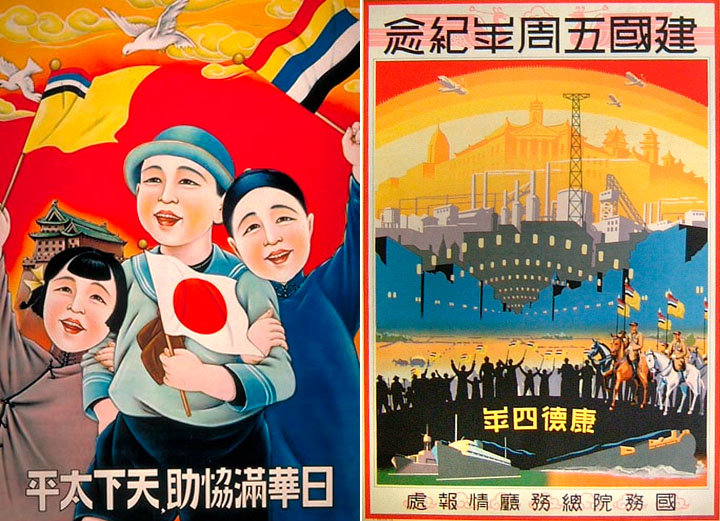 (images
via)
Another result of World War Two was the division of Germany, and here’s
the flag of the now defunct East Germany, or as it was formerly
known, the German Democratic Republic, which lasted from 1949 to 1990:
(images
via)
Another result of World War Two was the division of Germany, and here’s
the flag of the now defunct East Germany, or as it was formerly
known, the German Democratic Republic, which lasted from 1949 to 1990:
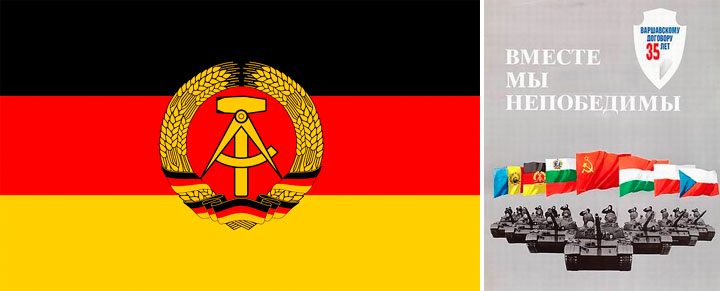 (right:
Warsaw Pact
poster "Together We Are Invincible!")
Many sultans used different personal "avatars"...er, banners
The Ottoman Empire, also known as the Turkish Empire, was founded
in the early fourteenth century and came to an end after the First World
War. At the height of its power in the sixteenth and seventeenth
centuries, the empire controlled North Africa, Western Asia and most of
South Eastern Europe. Various flags were used within the Empire throughout
its existence and the sultans also used different personal banners. There
was no national flag until 1844 and the design was very similar to the
current flag of the Republic of Turkey, founded in 1923. However, here is
a flag used by the Ottoman army for some three hundred years from the mid
fifteenth century:
(right:
Warsaw Pact
poster "Together We Are Invincible!")
Many sultans used different personal "avatars"...er, banners
The Ottoman Empire, also known as the Turkish Empire, was founded
in the early fourteenth century and came to an end after the First World
War. At the height of its power in the sixteenth and seventeenth
centuries, the empire controlled North Africa, Western Asia and most of
South Eastern Europe. Various flags were used within the Empire throughout
its existence and the sultans also used different personal banners. There
was no national flag until 1844 and the design was very similar to the
current flag of the Republic of Turkey, founded in 1923. However, here is
a flag used by the Ottoman army for some three hundred years from the mid
fifteenth century:
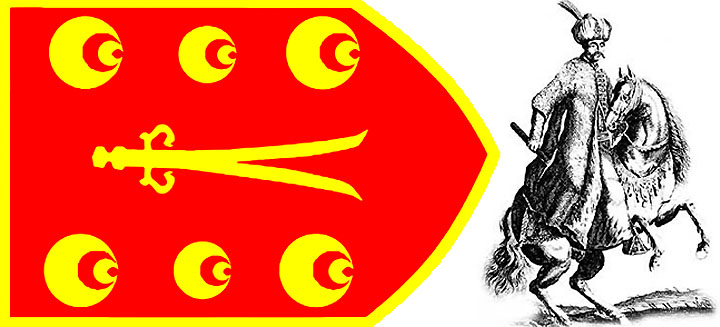 (image
via)
Every sultan tended to have his own banner, but a coat of arms, similar to
those prevalent in Europe, was created for Sultan Abdul Hamid II in 1882,
although it was never an official coat of arms for the Empire itself:
(image
via)
Every sultan tended to have his own banner, but a coat of arms, similar to
those prevalent in Europe, was created for Sultan Abdul Hamid II in 1882,
although it was never an official coat of arms for the Empire itself:
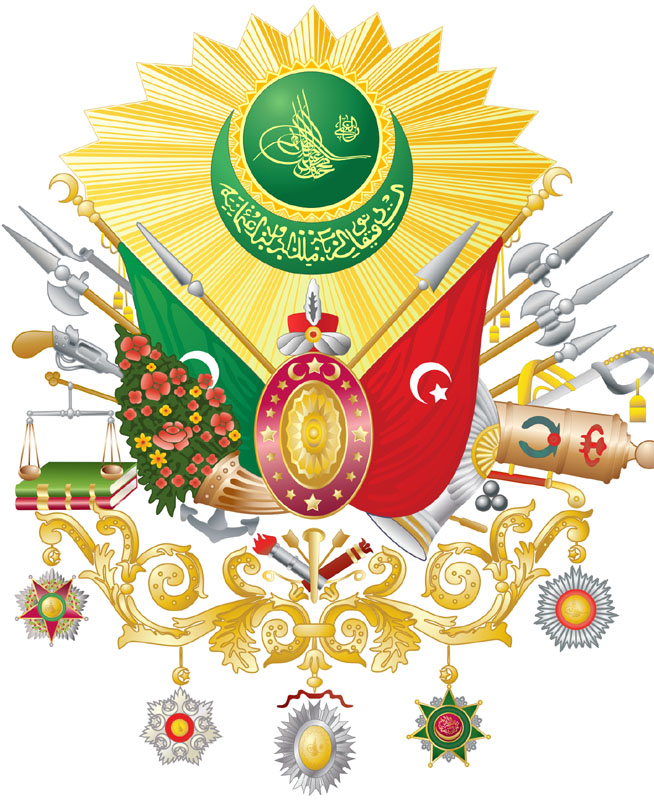 (image
via)
Greece was ruled by the Ottomans for centuries, until independence
was secured in the 1820’s. However, during the Turkish period, the Greeks
used a number of unofficial flags. This one was employed in certain parts
of the empire from 1431 to 1619 by the spachides, a cavalry unit:
(image
via)
Greece was ruled by the Ottomans for centuries, until independence
was secured in the 1820’s. However, during the Turkish period, the Greeks
used a number of unofficial flags. This one was employed in certain parts
of the empire from 1431 to 1619 by the spachides, a cavalry unit:
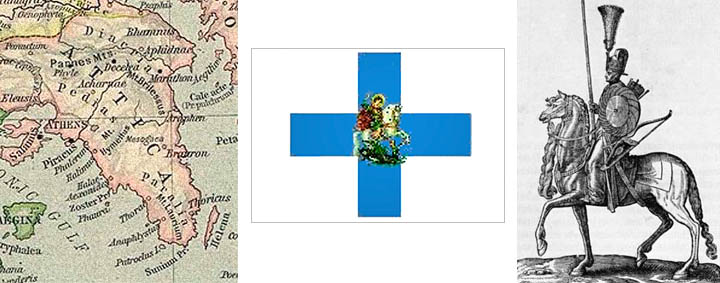 (images via)
After Otto, a prince of Bavaria in Germany, was made King of Greece in
1832, the country used this flag for several decades:
(images via)
After Otto, a prince of Bavaria in Germany, was made King of Greece in
1832, the country used this flag for several decades:
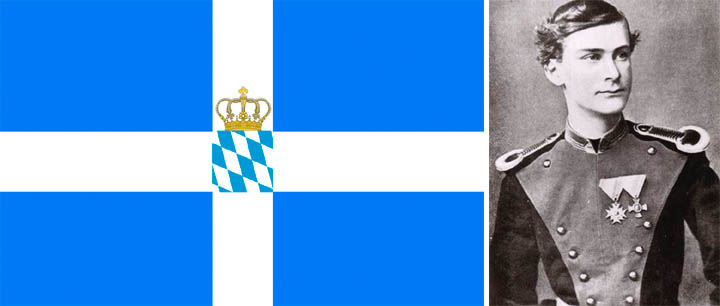 (image
via)
Forgotten British colonial variations
(image
via)
Forgotten British colonial variations
 (map of the British Empire, click to enlarge - via
Norman B Leventhal Map Centre)
There are lots of British colonial flags due to the extent and the life
span of the Empire, but here are a few examples of forgotten flags, such
as this one belonging to the British East India Company from 1707.
Note the absence of the diagonal red cross of St. Patrick on the Union
Jack, which was not added to the main British flag until after the Act of
Union with Ireland in 1801:
(map of the British Empire, click to enlarge - via
Norman B Leventhal Map Centre)
There are lots of British colonial flags due to the extent and the life
span of the Empire, but here are a few examples of forgotten flags, such
as this one belonging to the British East India Company from 1707.
Note the absence of the diagonal red cross of St. Patrick on the Union
Jack, which was not added to the main British flag until after the Act of
Union with Ireland in 1801:
 India was often described as the jewel in the Crown of the British
Empire. Here’s the flag of the Governor General, with a separate image
depicting the star pattern:
India was often described as the jewel in the Crown of the British
Empire. Here’s the flag of the Governor General, with a separate image
depicting the star pattern:
 (image
via)
Azad Hind was an Indian government in exile based in Singapore
after 1943, which was heavily dependent on support from Imperial Japan.
Its aim was to free India from British rule by allying itself with the
Axis powers:
(image
via)
Azad Hind was an Indian government in exile based in Singapore
after 1943, which was heavily dependent on support from Imperial Japan.
Its aim was to free India from British rule by allying itself with the
Axis powers:
 (right image: Azad Hind card, via
Ann Mette Heindorff)
Here are a couple of flags from colonial Hong Kong. The one on the
left dates from 1871, the one shown on the right was used from 1959 until
Hong Kong’s transfer back to China in 1997:
(right image: Azad Hind card, via
Ann Mette Heindorff)
Here are a couple of flags from colonial Hong Kong. The one on the
left dates from 1871, the one shown on the right was used from 1959 until
Hong Kong’s transfer back to China in 1997:
 Viceroyalties and Forgotten Federations
On the opposite side of the world, the West Indies Federation was
created from a number of British colonies in the Caribbean in 1958, but
only lasted until 1962:
Viceroyalties and Forgotten Federations
On the opposite side of the world, the West Indies Federation was
created from a number of British colonies in the Caribbean in 1958, but
only lasted until 1962:
 Another short-lived federation existed in the same part of the word over a
century earlier. The Federal Republic of Central America,
originally known as known as the United Provinces of Central America, was
created in 1823 from the former territory of the Captaincy General of
Guatemala, an administrative division of the Spanish Empire covering much
of the region. The republic included the modern countries of Guatemala, El
Salvador, Honduras, Nicaragua, and Costa Rica, but the union dissolved in
a civil war between 1838 and 1840:
Another short-lived federation existed in the same part of the word over a
century earlier. The Federal Republic of Central America,
originally known as known as the United Provinces of Central America, was
created in 1823 from the former territory of the Captaincy General of
Guatemala, an administrative division of the Spanish Empire covering much
of the region. The republic included the modern countries of Guatemala, El
Salvador, Honduras, Nicaragua, and Costa Rica, but the union dissolved in
a civil war between 1838 and 1840:
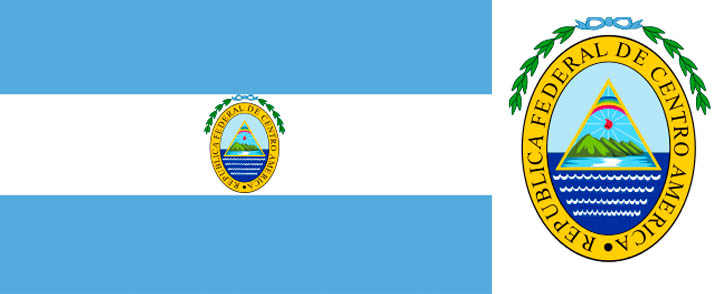 From 1535 to 1821, this was the flag of the
Viceroyalty of New Spain, which governed California, the South West
US, Mexico and much of Central America, plus the Spanish controlled
Caribbean islands (see image below, top right). Further south, the
Viceroyalty of New Granada came into being in 1717 in northern
South America, ruling over modern day Colombia, Ecuador, Panama and
Venezuela. The symbol (shown below on the left) was used on flags at some
of the forts on the coast in the eighteenth century:
From 1535 to 1821, this was the flag of the
Viceroyalty of New Spain, which governed California, the South West
US, Mexico and much of Central America, plus the Spanish controlled
Caribbean islands (see image below, top right). Further south, the
Viceroyalty of New Granada came into being in 1717 in northern
South America, ruling over modern day Colombia, Ecuador, Panama and
Venezuela. The symbol (shown below on the left) was used on flags at some
of the forts on the coast in the eighteenth century:
 Flags inside flags... inside flags...
In Africa, this was the flag of South Africa from 1928 to 1994. The
design is based on the Prince’s flag from the Netherlands, the banner of
the Prince of Orange in the Dutch War of Independence (1568-1648), with
the smaller flags of the Orange Free State and Transvaal, the former Boer
republics, plus the British Union Jack, in the centre:
Flags inside flags... inside flags...
In Africa, this was the flag of South Africa from 1928 to 1994. The
design is based on the Prince’s flag from the Netherlands, the banner of
the Prince of Orange in the Dutch War of Independence (1568-1648), with
the smaller flags of the Orange Free State and Transvaal, the former Boer
republics, plus the British Union Jack, in the centre:
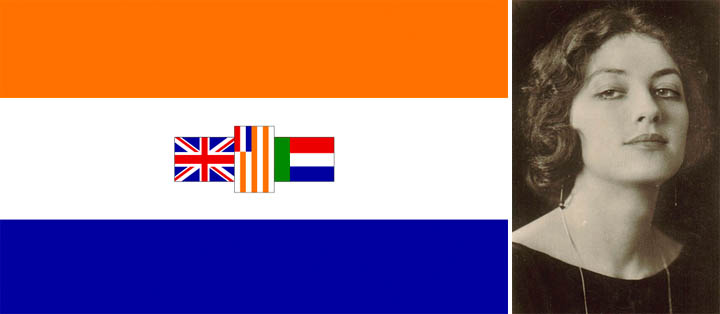 (right image: South African art deco postcard 1928,
via)
Elsewhere in Africa, the colonial era left a lasting legacy, since almost
the entire continent was once carved up by the European powers. This flag
belongs to German East Africa, or Tanganyika, which is now known as
Tanzania. Most other German colonial flags were similar, in red, black and
white, with a central crest or shield:
(right image: South African art deco postcard 1928,
via)
Elsewhere in Africa, the colonial era left a lasting legacy, since almost
the entire continent was once carved up by the European powers. This flag
belongs to German East Africa, or Tanganyika, which is now known as
Tanzania. Most other German colonial flags were similar, in red, black and
white, with a central crest or shield:
 (right image: hospital in Dar-Es-Salaam,
via)
The huge country in central Africa now known as the Democratic Republic of
the Congo was formerly called the Belgian Congo. Established as the
Congo Free State in 1885, the entire vast territory was originally
privately owned by the Belgian King Leopold II, until reports of major
human rights abuses against the native population forced the king to hand
the state over to Belgium in 1908. It became the Belgian Congo until the
independence movement began in 1960:
(right image: hospital in Dar-Es-Salaam,
via)
The huge country in central Africa now known as the Democratic Republic of
the Congo was formerly called the Belgian Congo. Established as the
Congo Free State in 1885, the entire vast territory was originally
privately owned by the Belgian King Leopold II, until reports of major
human rights abuses against the native population forced the king to hand
the state over to Belgium in 1908. It became the Belgian Congo until the
independence movement began in 1960:
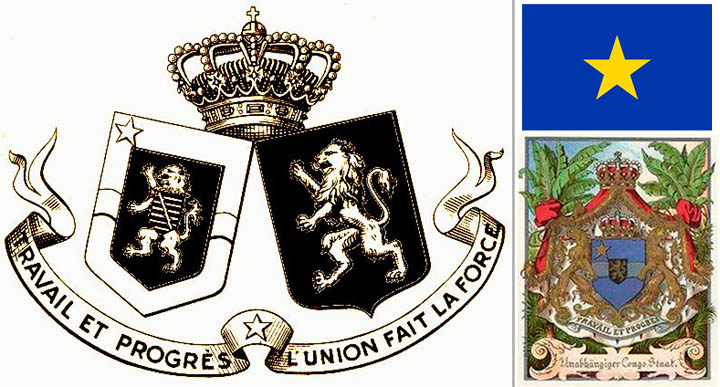 (images via)
Great Expectations
Finally, from down under, the Australian flag’s original design dates from
1901, but the oldest known Australian flag appeared almost a century
earlier. The Bowman Flag was created by John and Honor Bowman in 1806 and
raised at their home in New South Wales NSW to commemorate Nelson’s
victory at Trafalgar in October 1805. The flag features the English rose,
Scottish thistle and Irish shamrock, along with Nelson’s famous motto from
the battle ‘England expects that every man will do his duty’,
flanked by the emu and kangaroo, symbols of Australia:
(images via)
Great Expectations
Finally, from down under, the Australian flag’s original design dates from
1901, but the oldest known Australian flag appeared almost a century
earlier. The Bowman Flag was created by John and Honor Bowman in 1806 and
raised at their home in New South Wales NSW to commemorate Nelson’s
victory at Trafalgar in October 1805. The flag features the English rose,
Scottish thistle and Irish shamrock, along with Nelson’s famous motto from
the battle ‘England expects that every man will do his duty’,
flanked by the emu and kangaroo, symbols of Australia:
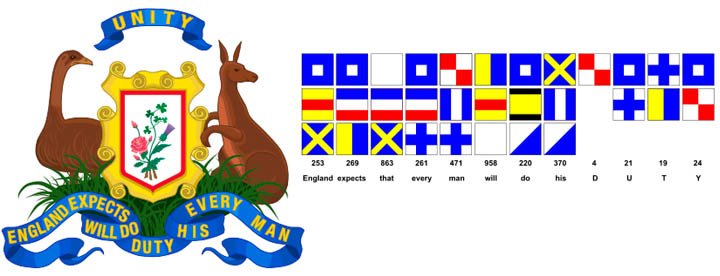 (image
via)
READ THE FIRST PART! ->
Simon Rose is the
author of science fiction and fantasy novels for children, including
The Alchemist's Portrait,
The Sorcerer's Letterbox,
The Clone Conspiracy,
The Emerald Curse,
The Heretic's Tomb
and
The Doomsday Mask.
(image
via)
READ THE FIRST PART! ->
Simon Rose is the
author of science fiction and fantasy novels for children, including
The Alchemist's Portrait,
The Sorcerer's Letterbox,
The Clone Conspiracy,
The Emerald Curse,
The Heretic's Tomb
and
The Doomsday Mask.
|










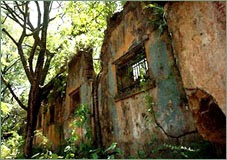




































































7 Comments:
nice collection, but one mistake: the GDR lasted from 1949 to 1990
The flag of Vichy France is totally badass. They should have kept it. :)
The GDR flag is my favourite of the former communist flags. I wonder what the present day replacement for a hammer and compass would be to represent blue and white collar workers.
You know, Vichy France was not really free...
Here is the flag of the Araucania and Patagonia Kingdom.
http://es.wikipedia.org/wiki/Reino_de_la_Araucan%C3%ADa_y_la_Patagonia
I find it awersome ,and really useful.It´s part of the History of the World.Thankyou for all that work!
This comment has been removed by the author.
Post a Comment
<< Home